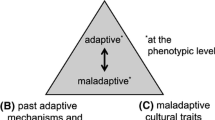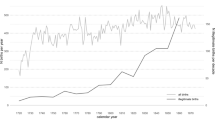Abstract
Life history theory predicts that greater extrinsic mortality will lead to earlier and higher fertility. To test this prediction, I examine the relationship between life expectancy at birth and several proxies for life history traits (ages at first sex and first marriage, total fertility rate, and ideal number of children), measured for both men and women. Data on sexual behaviors come from the Demographic and Health Surveys (DHS). Two separate samples are analyzed: a cross-sectional sample of 62 countries and a panel sample that includes multiple cross-sectional panels from 48 countries. Multivariate regression analysis is used to control for potential confounding variables. The results provide only partial support for the predictions, with greater support among women than men. However, the prediction is not supported in sub-Saharan African countries, most likely owing to the nonequilibrium conditions observed in sub-Saharan Africa with respect to life expectancy. The applicability of the model to understanding HIV/AIDS risk behaviors is discussed.
Similar content being viewed by others
References
Anderson, K. G., Beutel, A. M., & Maughan-Brown, B. (2007). HIV risk perceptions and first sexual intercourse among youth in Cape Town, South Africa. International Family Planning Perspectives, 33(3), 98–105.
Ashford, L. S. (2006). How HIV and AIDS affect populations. Washington: Population Reference Bureau.
Belsky, J., Steinberg, L., & Draper, P. (1991). Childhood experience, interpersonal development, and reproductive strategy: an evolutionary theory of socialization. Child Development, 62, 647–670.
Burger, O., Walker, R., & Hamilton, M. J. (2010). Lifetime reproductive effort in humans. Proceedings of the Royal Society, Series B: Biological Sciences, 27, 773–777
Burton, L. (1990). Teenage childbearing as an alternative life-course strategy in multigeneration black families. Human Nature, 1(2), 123–143.
Catania, J., Kegeles, S., & Coates, T. (1990). Towards an understanding of risk behavior: an AIDS risk reduction model (ARRM). Health Education Quarterly, 17(1), 121–141.
Central Intelligence Agency (2007). The World Factbook 2007. Washington, D.C. https://www.cia.gov/library/publications/the-world-factbook/.
Chisholm, J. (1993). Death, hope and sex: life-history theory and the development of reproductive strategies. Current Anthropology, 34(1), 1–24.
Chisholm, J., Quinlivan, J., Petersen, R., & Coall, D. (2005). Early stress predicts age at menarche and first birth, adult attachment and expected lifespan. Human Nature, 16(3), 233–265.
Clark, S. (2004). Early marriage and HIV risks in Sub-Saharan Africa. Studies In Family Planning, 35(3), 149–160.
Daly, M., & Wilson, M. (1988). Homicide. New York: Aldine de Gruyter.
DeRose, L. F. (2006). Higher community HIV prevalence predicts higher recent marital fertility in Kenya. Paper presented at the Population Association of America Annual Meeting, Los Angeles, CA.
DeRose, L. F., & Klein, M. L. (2005). Bifurcated fertility in areas with higher HIV prevalence? Evidence from the 2001–2002 Zambia Demographic and Health Survey. Paper presented at the XXV International Population Conference of the IUSSP in Tours, France.
Ellis, B. J. (2004). Timing of pubertal maturation in girls: an integrated life history approach. Psychological Bulletin, 130(6), 920–958.
Gant, L. M., Heath, K. M., & Ejikeme, G. G. (2009). Early motherhood, high mortality, and HIV/AIDS rates in sub-Saharan Africa. Journal of Social Work and Public Policy, 24, 39–46.
Geronimus, A. T. (1996a). Black/white differences in the relationship of maternal age to birthweight: a Population-based test of the weathering hypothesis. Social Science & Medicine, 42(4), 589–597.
Geronimus, A. T. (1996b). What teen mothers know. Human Nature, 7(4), 323–352.
Harvey, P. H., & Zammuto, R. M. (1985). Patterns of mortality and age at first reproduction in natural populations of mammals. Nature, 315, 319–320.
Heath, K. M., & Gant, L. M. (2004). Risky sexual behavior as an adaptive response to HIV/AIDS. Paper presented at the Human Behavior and Evolution Society meeting, Berlin, Germany.
Hill, E. M., Ross, L. T., & Low, B. (1997). The role of future unpredictability in human risk-taking. Human Nature, 8, 287–325.
Kaplan, H. (1996). A theory of fertility and parental investment in traditional and modern human societies. Yearbook of Physical Anthropology, 39, 91–135.
Kruger, D. J., & Nesse, R. M. (2006). An evolutionary life-history framework for understanding sex differences in human mortality rates. Human Nature, 17, 74–97.
Lamptey, P. R., Johnson, J. L., & Khan, M. (2006). The global challenge of HIV and AIDS. Population Bulletin, 61(1), 3–24.
Lancaster, J. B. (1991). A feminist and evolutionary biologist looks at women. Yearbook of Physical Anthropology, 34, 1–11.
Lancaster, J. B. (1997). The evolutionary history of human parental investment in relation to population growth and social stratification. In P. A. Gowaty (Ed.), Feminism and evolutionary biology (pp. 466–489). New York: Chapman and Hall.
Low, B. S., Simon, C. P., & Anderson, K. G. (2002). An evolutionary perspective on demographic transitions: Modeling multiple currencies. American Journal of Human Biology, 14, 149–167.
Low, B. S., Simon, C. P., & Anderson, K. G. (2003). The biodemography of modern women: Tradeoffs when resources become limiting. In J. Rodgers & H.-P. Kohler (Eds.), The biodemography of human reproduction and fertility (pp. 105–134). Boston: Kluwer Academic Publishers.
Low, B. S., Hazel, A., Parker, N., & Welch, K. B. (2008). Influences on women’s reproductive lives: unexpected ecological underpinnings. Cross-Cultural Research, 42(3), 201–219.
Mirowsky, J. (2005). Age at first birth, health and mortality. Journal of Health and Social Behavior, 46, 32–50.
Neff, J. A., & Crawford, S. L. (1998). The Health Belief Model and HIV risk behaviors: a causal model analysis among Anglos, African Americans and Mexican-Americans. Ethnicity & Health, 3(4), 283–299.
Population Reference Bureau. (2000). 2000 World Population Data Sheet. Washington: Population Reference Bureau.
Population Reference Bureau. (2001). 2001 World Population Data Sheet. Washington: Population Reference Bureau.
Population Reference Bureau. (2004). 2004 World Population Data Sheet. Washington: Population Reference Bureau.
Population Reference Bureau. (2007). 2007 World Population Data Sheet. Washington: Population Reference Bureau.
Promislow, D. E. L., & Harvey, P. H. (1991). Mortality rates and the evolution of mammal life histories. Acta Oecologica, 12(1), 119–137.
Quinlan, R. J. (2007). Human parental effort and environmental risk. Philosophical Transactions of the Royal Society of London. Series B, 274, 121–125.
Rosenstock, I. M., Strecher, V. J., & Becker, M. H. (1994). The health belief model and HIV risk behavior change. In R. DiClemente & J. Peterson (Eds.), Preventing AIDS: Theories and methods of behavioral interventions (pp. 5–24). New York: Plenum.
StataCorp. (2007). Stata statistical software: Release 10. College Station: StataCorp LP.
Stearns, S. C. (1992). The evolution of life histories. New York: Oxford University Press.
Ueyama, M., & Yamauchi, F. (2009). Marriage behavior response to prime-age adult mortality: evidence from Malawi. Demography, 46(1), 43–63.
UNAIDS. (2008). 2008 Report on the global AIDS epidemic. New York: United Nations Publications.
United Nations. (2005). Population and HIV/AIDS 2005. New York: United Nations Publications.
United Nations (2008). World fertility patterns 2007. www.un.org/esa/population/publications/worldfertility2007/worldfertility2007.htm. Accessed 11/08/08.
Walker, R. S., Gurven, M., Burger, O., & Hamilton, M. J. (2008). The trade-off between number and size of offspring in humans and other primates. Proceedings of the Royal Society of London. Series B, 275, 827–833.
Wilson, M., & Daly, M. (1997). Life expectancy, economic inequality, homicide, and reproductive timing in Chicago neighborhoods. British Medical Journal, 314, 1271–1274.
Wojcicki, J. M. (2004). Socioeconomic status as a risk factor for HIV infection in women in East, Central and Southern Africa: a systematic review. Journal of Biosocial Science, 37(1), 1–36.
Acknowledgments
Ann Beutel, Sarah Burgard, Chris Kuzawa, Bobbi Low, Dawn Neill, Mary Shenk, Carl Simon, and several anonymous reviewers all provided helpful feedback and criticism. I thank as well the participants of the IUSSP Seminar on the Ecology of the Male Life Course at Castle of Rauischholzhausen, Germany, for their helpful comments on an earlier version of this manuscript.
Author information
Authors and Affiliations
Corresponding author
Appendix
Appendix
Appendix A
Appendix B
Rights and permissions
About this article
Cite this article
Anderson, K.G. Life Expectancy and the Timing of Life History Events in Developing Countries. Hum Nat 21, 103–123 (2010). https://doi.org/10.1007/s12110-010-9087-z
Published:
Issue Date:
DOI: https://doi.org/10.1007/s12110-010-9087-z




